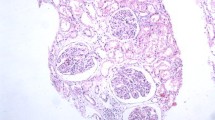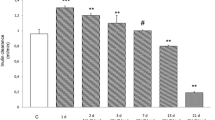Abstract
Changes in lipid metabolism are an important risk factor for vascular complications during chronic renal failure (CRF). In experimental CRF hypercholesterolemia has been found to be the main lipid disorder. It is probably due to enhanced cholesterologenesis. Mechanisms of these changes remain poorly understood. It is well known that activity of cholesterologenesis undergoes a significant diurnal rhythm. However, there was no evidence that this rhythm is still present in the course of experimental CRF. Results of our studies indicate that in contrast to puromycin induced nephrotic syndrome, diurnal rhythm of cholesterologenesis in CRF rats is preserved both in liver and in the intestine tissue. Significant higher incorporation of tritiated water into cholesterol fraction was found in vivo both in liver as well as in intestine of CRF rats, as compared to control animals. Increased (with comparison to the controls) incorporation of 14C-acetate, and 3H-mevalonate into CRF rat liver sterols indicate that mechanism of enhanced cholesterologenesis is more complex than simply due to the elevated level of mevalonate (potential substrate for cholesterologenesis) which has been reported in plasma of CRF animals.
Similar content being viewed by others
References
Hirano H, Yamada Y, Otani H, Kodama N, Mune M, Yukawa S: Evaluation of serum lipid abnormalities in chronic nephritis. Kidney Int 56: S147–149, 1999
Drueke TB: Genesis of atherosclerosis in uremic patients. Miner Electr Metab 25: 251–257, 1999
Attman PO, Alaupovic P, Samuelsson O: Lipoprotein abnormalities as a risk factor for progressive nondiabetic renal disease. Kidney Int 56: S14–17, 1999
Kasiske BL, O'Donnell MP, Garvis WJ, Keane WF: Pharmacologic treatment of hyperlipidemia reduces glomerular injury in rat 5/6 nephrectomy model of chronic renal failure. Circ Res 62: 367–374, 1988
O'Donnell MP, Kasiske BL, Katz SA, Schmitz PG, Keane WF: Lovastatin but not Enalapril reduces glomerular injury in Dahl salt-sensitive rats. Hypertension 20: 651–658, 1992
Shoji T, Nishizawa Y, Toyokawa A, Kawagashi T, Okuno Y, Morii H: Decreased albuminuria by pravastatin in hyperlipidemic diabetics. Nephron 59: 664–665, 1991
Rabelink AJ, Hene RJ, Erkelens DW, Joles JA, Koomans HA: Partial remission of nephrotic syndrome in patients on long-term simvastatin. Lancet 335: 1045, 1990
Szołkiewicz M, Bogusławski W, Świerczyński J, Rutkowski B: Rate of lipogenesis and cholesterologenesis in vivo during experimental chronic renal failure in rats. Wien Klin Wochenschr 110 (suppl 4): 45, 1998
Liang K, Vaziri ND: Gene expression of LDL receptor, HMG-CoA reductase, and cholesterol 7-alpha-hydroxylaze in chronic renal failure. Nephrol Dial Transplant 12: 1381–1386, 1997
Pandak WM, Vlahcevic ZR, Heuman DN, Krieg RJ, Hanna JD, Chan JC: Post-trancriptional regulation of 3-hydroxy-3-methylglutaryl coenzyme A reductase and cholesterol 7-alpha-hydroxylaze in rast with subtotal nephrectomy. Kidney Int 46: 358–364, 1994
Beg ZH, Stonik JA, Brewer HB: Modulation of the enzymic activity of 3-hydroxy-3-methylglutharyl coenzyme A reductase by multiple kinase system involving reversible phosphorylation. Rev Metab 36: 900–917, 1987
Ness GC, Chambers CM: The diurnal variation of hepatic HMG-CoA reductase activity is due to changes in the level of immunoreactive protein. Arch Biochem Biophys 327: 41–44, 1996
Thabet MA, Challa A, Chan JC, Pandak WM, Heuman DM, Vlahcevic ZR: Studies on alteration of hepatic cholesterol metabolism in puromycin-induced nephrotic syndrome in rats. Kidney Int 44: 789–794, 1993
Scoppola A, Galiano A: The mevalonate pathway and renal diseases: experimental and clinical implications. Int J Artificial Org 21: 243–246, 1998
Świerczyński J, Korczyńska J, Szołkiewicz M, Karbowska J, Kochan Z, Niewłgłowski T, Kusiak E, Rutkowski B: Low leptin mRNA level in adipose tissue and normoleptinemia in experimental chronic renal failure. Exp Nephrol 9: 54–59, 2001
Sperry WM, Webb M: A revision of the Schoenheimer-Sperry method for cholesterol determination. J Biol Chem 187: 97–106, 1950
Luk JK, Wong EF, Wong NL: Downregulation of atrial natriuretic factor clearance receptors in experimental chronic renal failure rats. Am J Physiol 269: H902–H908, 1995
Vaziri ND, Liang K: Downregulation of VLDL receptor expression in experimental chronic renal failure. Kidney Int 51: 913–919, 1997
Scoppola A, De Paolis P, Menziger G, Lala A, Di Giulio S: Plasma mevalonate in uremic patients. Kidney Int 51: 908–912, 1997
Author information
Authors and Affiliations
Corresponding author
Rights and permissions
About this article
Cite this article
Chmielewski, M., Nieweglowski, T., Swierczynski, J. et al. Diurnal rhythm of cholesterol biosynthesis in experimental chronic renal failure. Mol Cell Biochem 228, 33–37 (2001). https://doi.org/10.1023/A:1013395921241
Issue Date:
DOI: https://doi.org/10.1023/A:1013395921241




